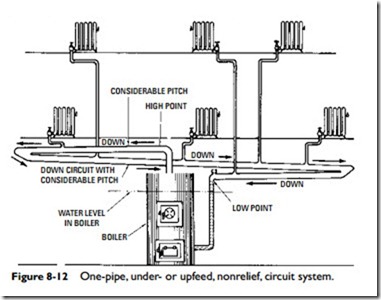One-Pipe Circuit System
In the one-pipe circuit system the steam main is carried entirely around the basement, taken off from the boiler by an elbow at the high point, as in Figure 8-12.
Note that the main must incline all the way from the high point to the low point. To allow for this inclination requires twice as much riser between high and low points as with the divided-circuit system, that is, where there are two mains taken off from a tee connection.
The one-pipe system is adapted for a rectangular building of low or moderate size. The size of the main (since all the steam flows through it) must be larger than in the divided-circuit system. However, especially in large installations, savings in piping may be made by installing a tapered main. A tapered main is one that is reduced in size along its length by connecting lengths of different- sized pipes with reducers. Eccentric reducers should be used to avoid water pockets, which would interfere with the proper drainage of the condensate. The risers are connected by being tapped from the main at various points to serve the heat-emitting units.
In a one-pipe system, the condensate drains into the main, flows in the same direction as the steam flow, and is carried to the drip pipe and then into the boiler. Since there is no return pipe as with the relief system, the circuit arrangement is less expensive to install.
Proportioning a tapered main is very important. The amount of condensate increases from the beginning to the end of the main and is considerable near the end, depending upon the number of
heat-emitting units. Allowance should be made for this, and too much tapering should be avoided.
